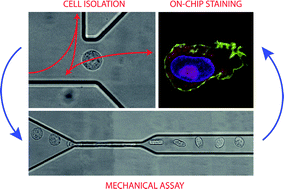A simple microfluidic method to select, isolate, and manipulate single-cells in mechanical and biochemical assays†
Abstract
This article describes a simple and low-tech microfluidic method for single-

* Corresponding authors
a Université de Mons, Laboratoire Interfaces & Fluides Complexes, Centre d'Innovation et de Recherche en Matériaux (CIRMAP), 20, Place du Parc, B-7000 Mons, Belgique
b
Université de la Méditerranée, Adhesion & Inflammation, INSERM U600-CNRS UMR6212, 163 Av. de Luminy, F-13009 Marseille, France
E-mail:
olivier.theodoly@inserm.fr
Fax: +33 (0)4 91 82 88 69
Tel: +33 (0)4 91 82 88 51
This article describes a simple and low-tech microfluidic method for single-

 Please wait while we load your content...
Something went wrong. Try again?
Please wait while we load your content...
Something went wrong. Try again?
S. Gabriele, M. Versaevel, P. Preira and O. Théodoly, Lab Chip, 2010, 10, 1459 DOI: 10.1039/C002257H
To request permission to reproduce material from this article, please go to the Copyright Clearance Center request page.
If you are an author contributing to an RSC publication, you do not need to request permission provided correct acknowledgement is given.
If you are the author of this article, you do not need to request permission to reproduce figures and diagrams provided correct acknowledgement is given. If you want to reproduce the whole article in a third-party publication (excluding your thesis/dissertation for which permission is not required) please go to the Copyright Clearance Center request page.
Read more about how to correctly acknowledge RSC content.
 Fetching data from CrossRef.
Fetching data from CrossRef.
This may take some time to load.
Loading related content
